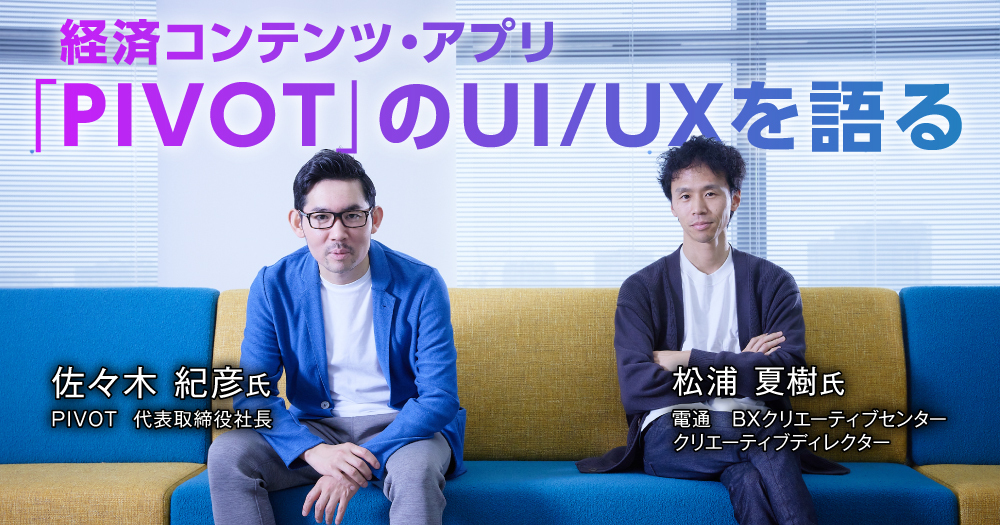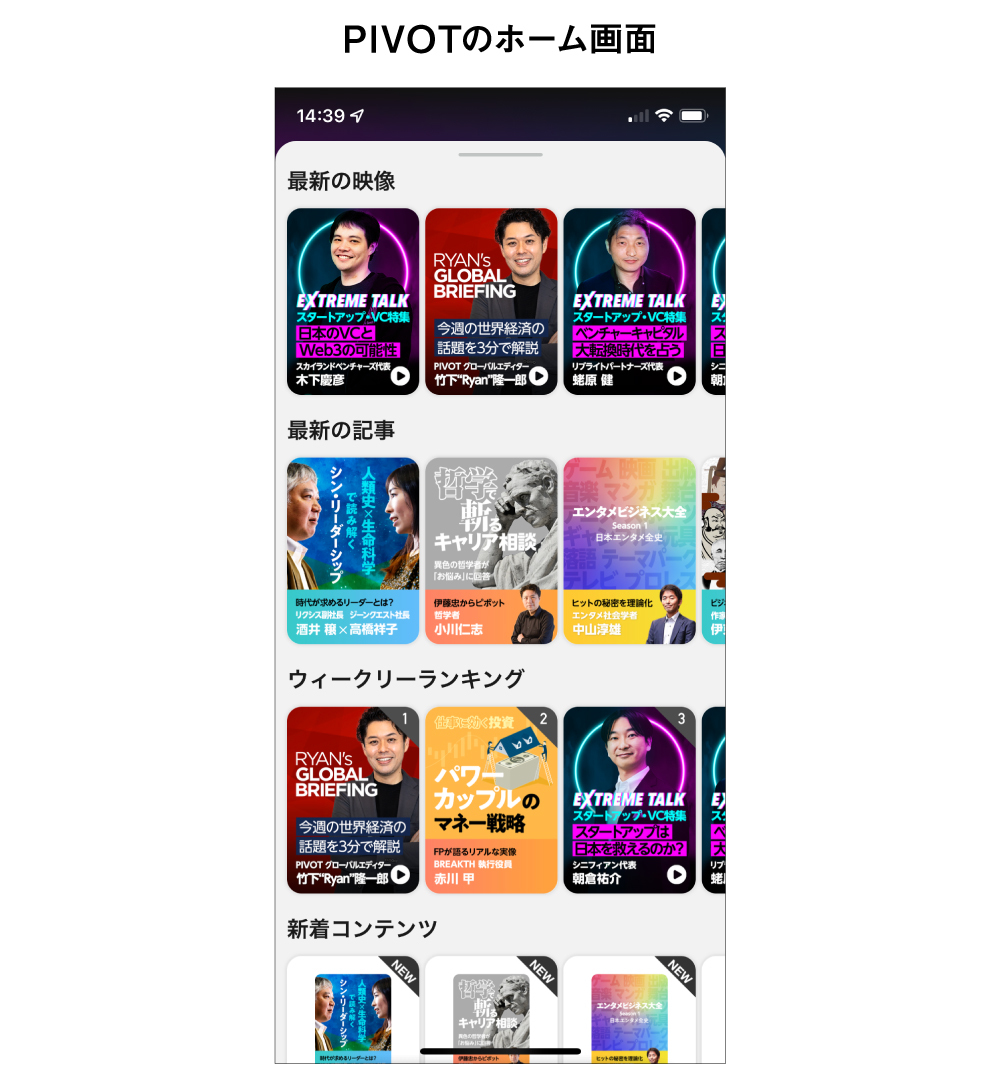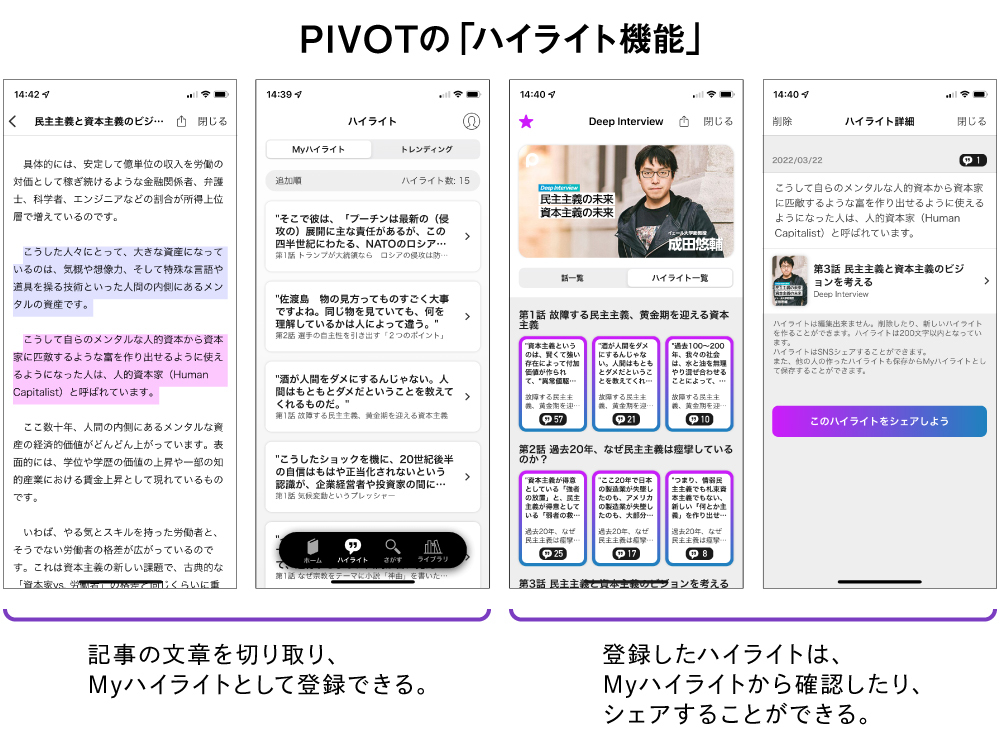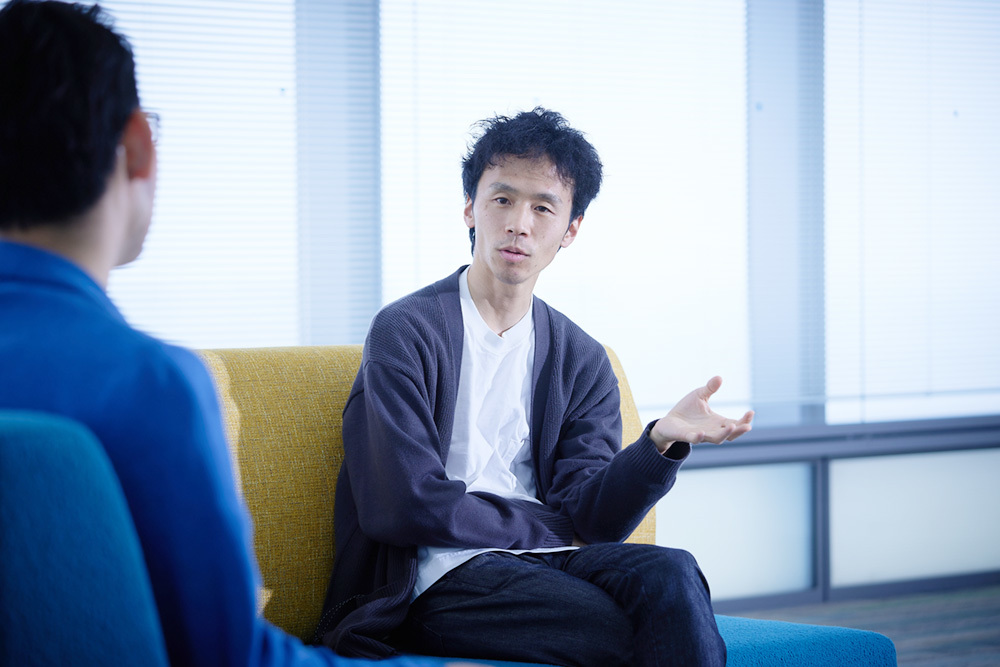The Economic Content App "PIVOT" is Born! Exploring the UI/UX Design

Norihiko Sasaki
PIVOT Co., Ltd.

Natsuki Matsuura
Dentsu Inc.
Launched in March 2022, the economic content app "PIVOT" has garnered attention as a media platform founded by Norihiko Sasaki, former editor-in-chief of "Toyo Keizai Online" and "NewsPicks." This time, Dentsu Inc. Creative Director Natsuki Matsuura, who led the UI/UX development for "PIVOT," engages in a dialogue with Mr. Sasaki. They discuss the UI/UX of "PIVOT."

Aiming to be a media platform where content you want to revisit gathers
──First, could you give us an overview of what kind of media "PIVOT" is?
Sasaki: "PIVOT" is a term often used in the startup world, meaning "change of direction." Right now, Japan and the world, regions, companies, and individuals alike, are entering a period where we must pivot while valuing what we've built up until now. It's precisely the time for Japan to pivot.
PIVOT's main target audience is people in their 20s to early 40s. We want to deliver content that provides this generation with the wisdom and courage for a new era, aiming to actually move the economy and people.
Since I previously served as Editor-in-Chief of "NewsPicks," I'm often asked, "How is 'PIVOT' different?" "PIVOT" aims to publish a wealth of content that offers deep and engaging learning for business professionals—content that, like books, is meant to be read and savored over time—rather than being a media outlet focused on rapidly disseminating news. For PIVOT's UI/UX development, we enlisted the help of Mr. Matsuura and the entire Dentsu Inc. team.
Matsuura: Sasaki-san mentioned the keyword "book" earlier. From our very first meeting, he emphasized, "I don't want this to be a media platform filled with content that's consumed and forgotten immediately."
I see "PIVOT" less as a news media outlet and more as a platform for practical learning content. Its UI/UX is designed with the intention of making users want to revisit it (read it) multiple times and feel the joy of owning the content. The layout and design of the app's home screen embody this concept.

The home screen displays thumbnails designed like book covers lined up in a row. Tapping a thumbnail reveals the content titles: Episode 1, Episode 2, and so on. We embodied the image of selecting books in a bookstore.
Sasaki: When we first launched "PIVOT," users commented, "You've managed to gather so much content right from the start." Wouldn't you dislike a store with a poor selection when you first visit? So we worked hard to assemble content, but the fact that it appeared abundant was largely due to the power of UI design. We went through a lot of trial and error with the screen design alongside Matsuura-san.
Matsuura: We tested various sizes and layouts. We created numerous thumbnail designs, structural variations, and transition patterns, and had extensive discussions about them.
Developing "Highlights" to share memorable parts of articles
──"Highlights" is also one of PIVOT's major features, right?
Matsuura: The Highlight feature lets users cut out and save their favorite passages from content, or share them with others.

Sasaki: This was a feature Matsuura-san was particularly passionate about. Actually, before designing Highlights, whether to include a comment feature was a major debate. As a platform operator, comment features are incredibly useful for attracting users. They're perfect for creating buzz, but we debated, "Is this really good for society?"
From the content creator's perspective, constructive feedback is appreciated. However, many creators become mentally drained by harsh comments, including defamatory remarks. Such comments tend to increase under anonymity. At NewsPicks, we also had heated debates about comments. How can we effectively highlight and amplify positive comments and constructive feedback? On the other hand, how can we reduce defamatory comments?
Matsuura: It's a difficult problem. That said, if we start by setting rules like "Please comment in this manner," it introduces significant bias. Also, even if someone likes the content, they might not be able to express themselves well according to our rules.
Sasaki: NewsPicks switched from anonymous to real-name comments partway through. This improved the situation where comment sections would get out of hand. Responsible comments increased, but then we hit the problem of reduced diversity. People who can speak under their real names tend to be freelancers or those not affiliated with organizations, so the content becomes skewed. In Japan, many people, like those working for large corporations, are prohibited from commenting and find it difficult to speak up under their real names. Honestly, we hit a wall there. That said, having no feedback at all isn't good either. Finding the right balance is a major challenge for content feedback in the digital age. At PIVOT, since we don't have a comment section within the app, we want to fully utilize platforms like Twitter and YouTube to communicate with our users.

Matsuura: After exchanging various opinions with Sasaki, we concluded that the best approach might be to allow users to highlight only their favorite sentences within the content, without any comments or bias. We want the "Highlight" feature to clearly convey respect for the content while also encouraging creators to focus on making their main text compelling.
Comments can be positive or negative, but with highlights, no one would deliberately cut out content they don't agree with. Since you can share only the parts you find good about the content, I think it's positive. Highlights are one feature built by working backward from this vision.
Sasaki: Reflecting on my own experience, I thought, "Quoting is sufficient." The parts users themselves find interesting—aren't those the most valuable aspects of the content? Even when reading a book, you underline the important parts, right? We envision realizing a "sharing of wisdom" where the substance of the content itself is shared and spreads widely, without relying on comments.
Matsuura: Exactly. From my own experience, I often read interesting articles, but when I try to find them later, I frequently think, "Where was that again?" Highlights solve that problem. On the Highlights page, the passages you've clipped are listed, letting you get straight to the core content and easily share it with others.
Proposing a new platform sparks new behaviors
──What other features does "PIVOT" have?
Sasaki: Another key feature of "PIVOT" is that it's a "hybrid content" platform, incorporating not just text and images, but also video and audio. We plan to significantly expand our video and audio content going forward.
Matsuura: In our meeting, Sasaki-san and I agreed that "audio media is likely to gain significant attention going forward," right?
Sasaki: With the pandemic driving more remote work, "background listening" has surged dramatically. The value of content you can consume just by listening has skyrocketed. Radio station representatives tell us podcasts, for instance, are seeing massive user growth among precisely our target demographic: people in their 20s to 40s.
We've discussed with Matsuura that we need to respond quickly to this demand, as the way early adopters consume information—especially economic content—is changing dramatically. Capturing new markets is crucial for us as a new media platform.
Matsuura: "PIVOT" is designed with the idea of moving between different content formats based on the situation and purpose. For example, you might enjoy audio content while commuting on a crowded train, and save text content for later review.

──Please share your future outlook for "PIVOT."
Matsuura: Observing various digital media today, we see established formats—news media should be like this, video streaming services should be like that. Within this landscape, I believe "PIVOT" has proposed a new way to engage with content.
Sasaki: As a first step, Matsuura-san really embodied my vision well. Going forward, it's about how we can get closer to what users are seeking.
Matsuura: Exactly. We want to keep delivering not just user-friendly features, but also proactive suggestions. During development of "Highlights," there were opinions suggesting standard comment or share functions might be better. However, we believed it's necessary to try new things if they seem capable of realizing a better future, rather than simply adopting existing solutions. That's why we stuck with it until the end.
In corporate branding too, isn't it crucial to clearly define the vision your company wants to achieve and then deliver on it? I believe we can do that in platform design as well.
──I imagine you're actually tuning things as you go, but do you have a next plan?
Sasaki: We're rushing to develop a web version viewable on PCs. With the increase in remote work, opportunities to read longer content on smartphones have decreased, and we feel the importance of being viewable on PC web browsers is growing.
Matsuura: That's right. For the past few years, UI/UX design has followed a mobile-first approach. But since I started remote work myself, I definitely think, "Yeah, I read longer articles on a PC."
Sasaki: I think the web version will be used differently than the app. For the highlight feature, for example, users could instantly pull up sections they've saved and share them right away with colleagues. We want to develop the web version while considering the unique strengths PIVOT can offer.
──Finally, Dentsu Inc. is strongly associated with advertising and marketing. Could you tell us about your UI/UX initiatives?
Matsuura: Whether this is Dentsu Inc.'s answer or my personal one is another matter. As both a UX designer and creative director, I see my role and work as providing new value to the world through experience design. Beyond just improvements and research, I want to increase our track record of creating things starting from vision and ideas, and make our value proposition more visible.
Sasaki: For platform operators and media companies, the UI/UX itself becomes the primary advertisement. How you design that is critically important. It requires more than just design; it demands the ability to create a worldview, think about content, and act as a generalist.
Matsuura: I studied architecture in university, and I feel what I'm doing now shares a similar approach. Architecture demands both beauty and usability, and sometimes requires new proposals. For example, taking down walls in a space previously divided into separate living, dining, and kitchen areas can propose a different way of living. Similarly, proposing new platforms sparks new behaviors in people.
Sasaki: The difference between traditional advertising and architecture is that with architecture, the real challenge begins after it's built. Our app development is the same, right? Teaming up with Matsuura-san, I feel like "the real challenge starts now."
Matsuura: We want to keep evolving "PIVOT" by constantly engaging with our users. Thank you for today!
Was this article helpful?
Newsletter registration is here
We select and publish important news every day
For inquiries about this article
Author

Norihiko Sasaki
PIVOT Co., Ltd.
Born in 1979. Graduated from Keio University's Faculty of Policy Management and earned a master's degree from Stanford University Graduate School (specializing in International Political Economy). After covering the automotive and IT industries at Toyo Keizai Inc., he became Editor-in-Chief of Toyo Keizai Online. In 2014, he became the inaugural Editor-in-Chief of NewsPicks. He also served as the first CEO of NewsPicks Studios, which handles video production. In June 2021, he founded PIVOT and assumed the role of CEO. His publications include "Are American-Made Elites Really That Impressive?", "Can Media Make Money in Five Years?", and "The Case for Entrepreneurship".

Natsuki Matsuura
Dentsu Inc.
Master of Engineering. After working in R&D, marketing, and digital creative, currently engaged in service and product development through UX design. Development experience spans apps, digital services, furniture, store design, and DX for large-scale sporting events. Recipient of the Good Design Award, D&AD Awards, and advertising awards.

